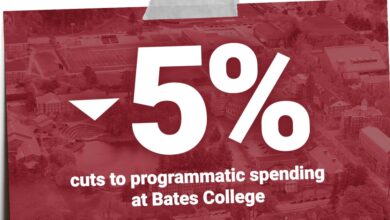Can the University of Montana Escape Its Past?

[ad_1]
Nearly a decade after harrowing reports of sexual assaults rocked the University of Montana at Missoula, the institution is again making headlines for issues related to sexism and sexual misconduct.
Students at the law school staged a walkout in early October, alleging administrators had dissuaded students from reporting instances of sexual misconduct to university officials. Both the dean and an associate dean have since stepped down.
A week later the student newspaper unearthed a blog in which a tenured faculty member criticizes the LGBTQ community, exhorts men to marry women in their late teens, and advocates violence against “communists.”
In addition, four women who have worked at the university filed a lawsuit charging that the administration had discriminated against them for their age, gender, and physical appearance.
The combination of those events would be bad enough at any college. At the University of Montana, they amount to ripping the scar tissue off an old wound — a painful reminder of a reputation the institution has struggled to shed.
In 2013 the university agreed to a settlement with the U.S. Department of Education to correct widespread problems in complying with Title IX, the federal law requiring gender equity in education. The university also paid a $1–million fine for failing to document reports of campus crime under the federal Clery Act.
Montana’s troubles were catapulted back into the national spotlight in 2015, when the best-selling author Jon Krakauer published a book that detailed the failings of local law-enforcement officials in investigating and prosecuting several alleged sexual assaults at Missoula from 2010 to 2012.
Montana’s current problems may be serious, but the university is now a very different institution than the one depicted in that book, say many students and faculty members.
Those problems are also not unique to Montana, said Noah Durnell, president of the Associated Students of the University of Montana, and not the result of the administration’s indifference. For example, he said, the university reacted quickly to the blog, which reflects “a really positive change in the culture the administration wants to instill.”
Within hours of the news accounts of the blog, the offending faculty member had been suspended from teaching, barred from the campus, and prohibited from contacting any students, a university spokesman said. The university is investigating.
‘Narrow Instances’
Dave Kuntz, director of strategic communications, characterized the recent spate of incidents as a positive sign — that students feel comfortable speaking out and demanding change.
“These are three very narrow instances that are at odds with a decade-long trend here at the University of Montana of empowering female leaders,” Kuntz said in an email.
The university also spent more than a year and some $75,000 on an outside investigation into students and staff members at the law school, Kuntz said, as well as applying internal scrutiny from the Title IX office and others. The university is now undergoing another external review of the law school’s responses to Title IX reports, “to improve the mechanisms that are in place … to best serve students,” he wrote.
Although the dean and associate dean of the law school resigned after the walkout, Kuntz said, “there have been no findings that law-school leadership put up any barriers to reporting sexual misconduct.”
Meanwhile, Kuntz called the lawsuit, by one current and three former employees, “not factual and without merit.”
“We have no intention to settle this case,” he said, “and are prepared to go to court to ensure the facts are elevated.”
Lawyers representing the women in the lawsuit did not respond to requests for comment.
Kuntz said the university had been “a national leader in gender equity and leadership empowerment for the past decade,” pointing to several women’s leadership initiatives on campus. “The majority of our students, our deans, and the president’s leadership cabinet are women.”
That doesn’t mean, however, that there’s no room for improvement, said Danielle Pease, a law-school student who is also a member of the student government. Pease, who said she was a survivor of rape as an undergraduate at the university, is an author of a resolution calling on the administration to recognize the harm that has been done to students who were subject to sexual misconduct or discrimination. The resolution also recommends several policy changes.
The institution, she said, cannot move on from its past without fully acknowledging the problem and the harm done to students.
“Without directly addressing the failures,” Pease said in an email, “the university is inadvertently telling students that conduct of that nature is OK, the university will not respond adequately, policy bare minimums are the only thing that the university should do, and that they do not care to address the underlying causes of the mishandlings and the implications the mishandlings have had on the survivors and nonsurvivors.”
‘I Want to Believe’
Now as in the past, reputation is among a college’s most precious commodities. A good reputation attracts top students and their tuition dollars, talented faculty members who bring with them coveted research grants and contracts, and the admiration and gifts of alumni and other donors.
A poor reputation can rob an institution of all those things and more, including the morale of everyone on campus. People at the University of Montana seem ready to shed the campus’s reputation as a haven for sexual misconduct.
“Krakauer’s book was salacious,” said Kimber Haddix McKay, a professor of public- and community-health sciences and chair of the Faculty Senate. “It would be incredibly refreshing for journalists to write about the incredible things happening here.”
It may be tempting to connect the current complaints of sexual misconduct and sexism to past events, McKay said, but that isn’t fair or an accurate picture of what’s happening at the university.
Students are very active and outspoken on the campus, McKay said, but they also don’t have access to all the facts in cases involving personnel decisions.
And morale on campus right now is better than it has been in a long time, she said, because enrollment is up for the first time in a decade. From 2011 to 2019, undergraduate enrollment fell nearly 40 percent — the largest decline at a public flagship in the nation. At the time, administrators noted the reputational damage but said the enrollment declines had stemmed from a wide range of factors.
Changing the university’s culture has been grueling work, but it has paid off, said Christine Fiore, a professor of clinical psychology who helped design the safe-campus surveys required under the university’s 2013 agreement with the Education Department and who researches sexual violence against women.
“We did a lot of work to address systemic issues,” Fiore said.
Some students, too, say the university has moved on from a dark period.
Mia McKinney, a senior studying sociology and women’s gender and sexuality, said the university is doing a good job of supporting marginalized students on campus. In turn, she said, those students are resilient and able to speak freely about how they need to be supported.
Betta Lyon Delsordo, a senior computer-science major, also praised students for their activism and efforts to hold the administration accountable, though she and other students said that work is tiring. They would like the administration to be more proactive in preventing problems, not wait to be called out by students, said Delsordo.
“I want to believe in the University of Montana and the people who are doing good work,” Delsordo said. “The university should be reflective of the people who are trying to make it better.”
[ad_2]
Source link






